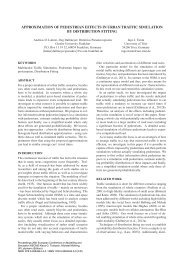Pedestrian Simulation for Urban Traffic Scenarios
Pedestrian Simulation for Urban Traffic Scenarios
Pedestrian Simulation for Urban Traffic Scenarios
Create successful ePaper yourself
Turn your PDF publications into a flip-book with our unique Google optimized e-Paper software.
Figure 2. <strong>Pedestrian</strong> road crossing behavior.<br />
Figure 3. <strong>Pedestrian</strong> way: Measures and lanes.<br />
without right of way χ in � m · s −1� :<br />
α = N 1.75<br />
0.5 (1.33, 0.25) (2)<br />
β = N 1.5·α<br />
α (1.5, 0.5) (3)<br />
χ = N 2·α<br />
α (1.8, 0.5) (4)<br />
These values correspond to the literature review given in [11].<br />
Assuming that smaller interactions between pedestrians on<br />
sidewalks average in time and space, pedestrians move linearly<br />
without interaction with other pedestrians. For determining<br />
ECT , pedestrians are modeled with a base AF of<br />
AF = N +3<br />
−3 (−0.5, 1.0) (5)<br />
In order to cross a road, pedestrian p calculates ECT and enters<br />
the road, when no road user passes the current road position<br />
of p, be<strong>for</strong>e p leaves the road adding a safety distance<br />
of two seconds, as shown in Figure 2. In this example, the<br />
pedestrian will not cross the road, because the car on the right<br />
side will reach its position be<strong>for</strong>e the crossing is done with<br />
the safety distance of 2s.<br />
Crossing a road is done at right angle to the course of the<br />
EI. This is also done in linear movement, because it is unlikely<br />
that interaction with other pedestrians will occur in<br />
these situations. When a pedestrian has started crossing the<br />
road, he will not abort it. When ECT was too low (e.g., because<br />
of a negative AF), road users need to brake in order to<br />
avoid an accident. In these cases, cars are interfered by pedestrians.<br />
4.3 <strong>Pedestrian</strong> Interaction at Crossings<br />
Crossings are the places where pedestrians may interact<br />
with each other, e.g., because several pedestrians may use a<br />
traffic light at once. Thus, a microscopic model <strong>for</strong> pedestrian<br />
movement is used to model pedestrian ways, which are placed<br />
at NIs. Figure 3 shows the composition of pedestrian ways.<br />
1 function update(iteration)<br />
2 if iteration �= iterationOld then<br />
3 iterationOld ← iteration;<br />
4 checkQueue();<br />
5 <strong>for</strong>each <strong>Pedestrian</strong> p do<br />
6 determineUsableLanes())<br />
7 <strong>for</strong>each <strong>Pedestrian</strong> p do<br />
8 chooseLane()<br />
9 <strong>for</strong>each <strong>Pedestrian</strong> p do<br />
10 provideLane()<br />
11 <strong>for</strong>each <strong>Pedestrian</strong> p do<br />
12 calcV()<br />
13 <strong>for</strong>each <strong>Pedestrian</strong> p do<br />
14 f .pos ← f .pos + v;<br />
15 if f .pos ≥ l then<br />
16 f .crossingNI←false;<br />
17 remove(p);<br />
Figure 4. update()-method of way-objects.<br />
The pedestrian way is separated into w lanes (width of the<br />
crossing) and has a length of l (width of the EI to cross).<br />
The proposed model is a space continuous adaptation of the<br />
cellular automaton based model, described in [1], permitting<br />
individual pedestrian velocities, that are not covered by [1].<br />
The model reproduces the interaction between pedestrians,<br />
walking in both directions on the way object. The basic algorithm<br />
is shown in Figure 4.<br />
Whenever a pedestrian p is on a way object w, it <strong>for</strong>wards<br />
the update call to w. Lines 2 and 3 assure that the way is only<br />
updated once per iteration.<br />
Each pedestrian starting a crossing action on a way chooses<br />
its lane at first. If no free lane is available, one lane will be<br />
chosen randomly and the pedestrian will be put into a queue<br />
<strong>for</strong> waiting pedestrians. Line 4 checks <strong>for</strong> pedestrians, waiting<br />
to enter the way and adds them when their lane provides a free<br />
entry position.<br />
Each pedestrian p calculates the magnitude of usable lanes<br />
in the neighborhood N lane of its current lane as shown in<br />
equation 6.<br />
N lane = {p.lane − 1, p.lane, p.lane + 1} ∩ {1,··· ,w} (6)<br />
If possible sidestep positions of different pedestrians interfere<br />
with each other, only one of them may use the corresponding<br />
lane. Due to the avoidance of asynchronisms, the lane choosing<br />
process is divided into an update (line 8) and a provide<br />
(line 10) step.<br />
In line 8, each pedestrian p calculates the gaps g(l) to the<br />
next pedestrian <strong>for</strong> each lane l ∈ N lane in the direction of



